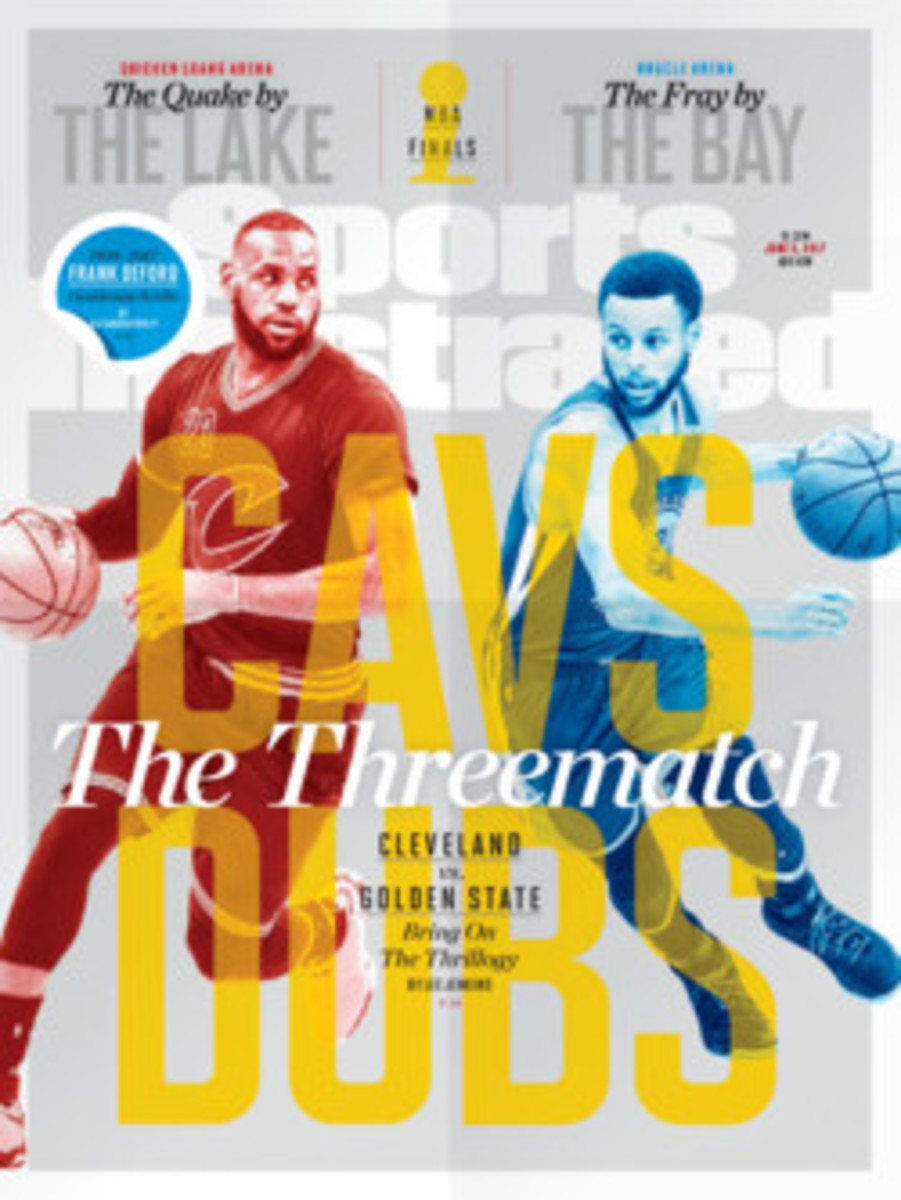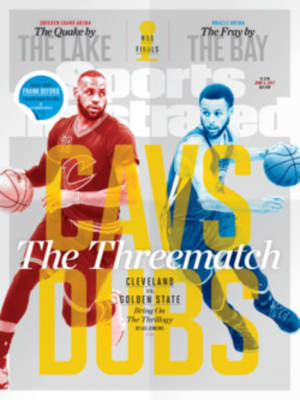
Frank Deford 1938-2017
AS A SENIOR on the basketball team at Gilman School, a prep school in Baltimore, Frank Deford suddenly found a groove with his jump shot. He set the school scoring record, made second-team All-City and got wind that his coach had called him the best "game player" he had ever coached. It was a spasm of stardom that caught him by surprise, and Frank puzzled over it for the rest of his life, which ended on Sunday in Key West, at age 78.
On the whole, our beloved senior contributing writer ran a charmed race, even beyond high school. It took him a little longer to navigate Princeton, after he got suspended midway through for having a woman in his dorm. ("It wasn't as exciting as it sounds," said Frank.) At 6'4", the tallest soldier in his Army company, he was chosen as "guide-on"—the guy who would carry the flag in a charge—an honor with little bodily risk at Fort Dix in 1961. He met Carol, the runway model he'd marry, at the beach. They had a son, Christian, in 1969, and, after greeting their baby daughter, Alexandra, two years later, they learned that she had cystic fibrosis. They would have only eight years with her before she died in January 1980.
The Defords didn't want to risk having another child of their own, but they feared they would condemn themselves to a lifetime of grief if they didn't do something. So they adopted a daughter for themselves, and a sister for Christian—Scarlet. That Alex's father suffered from failing lungs might be regarded as one last act of solidarity.
An SI editor once said that Deford wasn't so much a great stylist as someone whose humanity shone through in all that he wrote. And that—not the many peerlessly written profiles—is how he will be remembered in the House of SI, where he graced the magazine's masthead for more than a half century.
Copy chief Gabe Miller was privileged with a first look at much of what he filed. "His sensitivity comes through in everything he writes," says Miller. "He feels so much for others—maybe because of how much he has felt himself. He gave you the sense that what he was writing about was meaningful, without it seeming self-important. He wrote like he was shooting for something."
At Princeton, coach Cappy Cappon called the bluff of Deford's basketball career. Having noticed his contributions to The Daily Princetonian, he said, "You know, Deford, you write basketball much better than you play it." So Frank hied off to other corners of campus, undeterred. In a writing class with British novelist Kingsley Amis, Frank mentioned that New York Herald-Tribune sports columnist Red Smith was a worthy model, and Amis howled. (Deford would find inspiration in British sportswriters. Because soccer supplied so little quantifiable action, writers were unshackled, able to see a sport or match or tournament, as Frank once put it, "as less a competition and more a presentation.")
His future paymasters at Time Inc. got an early read on Deford's confidence when he came through Rockefeller Center for a round of interviews in the spring of 1962, weeks before he was to graduate. When an executive began counseling him on the various stops he'd be making through the day, Deford all but cut him off. He did not want to write for TIME ("group journalism," he called it) or for LIFE ("just pictures"). It was SI or bust. After a lunch with two SI editors, and an afternoon summit with top editor Andre Laguerre, he was signed as a reporter-researcher.
Yet for all the poise, and the figure he cut with his size and mustache and the dash of purple he always wore, he copped to shyness: "That's why most of us become journalists—we're shy, but we're also curious, and if you have a press card, then you have a professional excuse to ask questions of strangers, which you don't have the nerve to do in life."
By the 1970s, he had an updated calling card, the long profile that lit up the back of the magazine and featured a reliable virtue: Though never hit jobs, they always had an edge. It came from Deford's ability to pull back—to connect his subject to some larger context, or to see a person's life or significance in a grander sweep. Proof of the essentialist core of a Deford piece rests in the pith of the headlines that editors would run with them, whether the story was about tennis star Jimmy Connors (Raised by Women to Conquer Men) or NFL owner George Halas (I Don't Date Any Woman Under 48) or Indiana basketball coach Bob Knight (The Rabbit Hunter).
By the spring of 1989, Deford had been named National Sportswriter of the Year for the sixth time and just filed a long profile of boxer Archie Moore—his 100th extensive piece. It was time for a change. In a quixotic interlude as editor of the short-lived sports daily, The National, he drew down the account of a Mexican billionaire to hire a raft of talented peers, pay them handsomely and turn them loose—a concrete statement in defense of sportswriting. The National folded in 18 months, and after stopovers at Newsweek and Vanity Fair, he found his way back to the mothership.
There's a debate among historians of sportswriting about how SI has influenced the craft. Early in the 20th century Grantland Rice and his contemporaries pioneered the Gee Whiz style, "godding up" athletes and coaches, before yielding to the muckrakers and cynics who subscribed to the Aw Nuts! School. The two approaches converged in Dan Jenkins's account for this magazine of the 1966 meeting of two undefeated football teams, Notre Dame and Michigan State, in which the Irish passed up a chance to win and settled for a 10--10 tie. "Old Notre Dame will tie over all," taunted Jenkins, as he ripped Notre Dame coach Ara Parseghian (Aw nuts!) while valorizing how Irish quarterback Terry Hanratty had played through pain (Gee whiz!). That piece is regarded as the birth of the blend of snark and reverence that prevails in sportswriting today.
But another perspective would ascribe even more influence to Deford and his "bonus pieces," the 4,000- to 5,000-word features that appeared in SI. At first he went hors piste, filing assessments of roller derby or Soap Box Derby or Little Irvy, a frozen, 20-ton touring whale. But the humanity in him ultimately brought him back to ... humans. In appraisals not just of Connors and Knight, but also of Howard Cosell, Jimmy the Greek, Pete Rozelle, Bob Feller and Bill Russell, Deford picked up books long judged by their cover and actually opened them and pored over the pages. He didn't use many quotes from his subjects, for he didn't really want to yield the floor, but if he found one that somehow nailed his subject, he'd hammer at it. Repetition and callbacks were among his tricks, as was an acute feel for the architecture and pacing of a piece. As one of his editors, Myra Gelband, put it, "He'd hang bells throughout the story, and at the end go back and ring every one."
The same self-assuredness that people came to know from Deford's NPR commentaries on Wednesday mornings fired the stories he told on the page. His rhetorical confidence moved people to take sports, and by extension writing about sports, more seriously—if never quite as seriously as he might have liked. His prickliness would be deployed offensively as well as defensively; drawing a bead on some peeve, he could play the grumpy old man. "The pole dancing of sports journalism," he called blogging and statistics. And on the explosion of books catering to participants in the '70s running boom: "Run into the ocean, for all I care, run into the sunset, run off a cliff—but don't tell me about it."
The mastheads of SI A.D. (After Deford) are peopled with writers who grew up dazzled by him. Migrating from press box to press box, sounding out colleagues, they met others who had read and studied him, and felt ennobled in their own work because of what Frank had done to exalt the craft. During the height of Deford's Bonus Period, Washington Post sports editor George Solomon would make 40 copies of his latest piece and stuff one in each office mailbox. Because Deford wrote "like he's shooting for something," a generation of writers found themselves doing the same.
A few weeks ago, after more than 1,600 commentaries for NPR, Frank recorded his last one. His voice was just regionalist enough, with a trace of his native Bawlmer, to sound like a guy at the corner bar. ("You don't talk that tall," a listener once said upon meeting him.) But it had the requisite public-broadcasting erudition, as well as the insouciance that comes with not giving a rat's ass that uncountable brows in numberless Volvos will cloud over because you've said you don't like soccer.
As he told NPR's Tom Goldman earlier this month, "[Sports are] part of your life—it's the second tier. The first tier is eating, drinking and procreation. The second tier is religion, the spirit, music, art and the physical. Sports. It deserves to have as much attention paid to it, seriously."
Notwithstanding all those radio commentaries, Deford's legacy will be what he put to the page. When Barack Obama honored him with the National Humanities Medal in 2013, and at the ceremony mispronounced his name as "DEFF-erd," it wasn't because the president was unfamiliar with his work. Indeed, someone involved in the selection process later confided in Deford how Obama had taken a personal interest in making sure he was included among that year's honorees. That insistence, paired with an inability to properly pronounce Deford's name, suggests that the president, like so many of a certain generation, knew of Frank from his written work. Obama knew the voice that made its way into the minds of readers as their eyes moved from word to word to word.
And so, you see, of course (we're channeling pure Frank here—the swagger with which he would seize and guide the reader): After the great satisfaction of finishing the piece, the eye returns to the top, to find the stamp of validation that caused you to dive in; that sight to quicken the pulse of fans, readers and those of us privileged to work with him, By Frank Deford.
"That's why most of us become journalists," Deford said. "We're shy, but we're also curious."
The Week
What to Do
24
SI Edge
Go Polo
26
SI Grill
French Steak
28
Extra Mustard
30
Faces in The Crowd
32
THE ESSENTIAL FRANK DEFORD
RAISED BY WOMEN TO CONQUER MEN
AUG. 28, 1978
Why Jimmy Connors can never be one of the boys
THE RABBIT HUNTER
JAN. 26, 1981
Off the court, Indiana's Bobby Knight stalks the insignificant
THE TOUGHEST COACH THERE EVER WAS
APRIL 30, 1984
Robert Victor Sullivan was a unique man, representative of a time that has vanished
THE BOXER AND THE BLONDE
JUNE 17, 1985
Billy Conn won the girl he loved but lost the fight
THE RING LEADER
MAY 10, 1999
Bill Russell was the hub of a Celtics dynasty that ruled sports as no other

